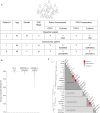Colon Cancer-Associated Fusobacterium nucleatum May Originate From the Oral Cavity and Reach Colon Tumors via the Circulatory System
- PMID: 32850497
- PMCID: PMC7426652
- DOI: 10.3389/fcimb.2020.00400
Colon Cancer-Associated Fusobacterium nucleatum May Originate From the Oral Cavity and Reach Colon Tumors via the Circulatory System
Abstract
Fusobacterium nucleatum is a common oral bacterium that is enriched in colorectal adenomas and adenocarcinomas (CRC). In humans, high fusobacterial CRC abundance is associated with chemoresistance and poor prognosis. In animal models, fusobacteria accelerate CRC progression. Targeting F. nucleatum may reduce fusobacteria cancer progression and therefore determining the origin of CRC F. nucleatum and the route by which it reaches colon tumors is of biologic and therapeutic importance. Arbitrarily primed PCR performed previously on matched same-patients CRC and saliva F. nucleatum isolates, suggested that CRC F. nucleatum may originate from the oral cavity. However, the origin of CRC fusobacteria as well as the route of their arrival to the tumor have not been well-established. Herein, we performed and analyzed whole genome sequencing of paired, same-patient oral, and CRC F. nucleatum isolates and confirmed that CRC-fusobacteria originate from the oral microbial reservoir. Oral fusobacteria may translocate to CRC by descending via the digestive tract or using the hematogenous route during frequent transient bacteremia caused by chewing, daily hygiene activities, or dental procedures. Using the orthotropic CT26 mouse model we previously showed that IV injected F. nucleatum colonize CRC. Here, we compared CRC colonization by gavage vs. intravenous inoculated F. nucleatum in the MC38 and CT26 mouse orthotropic CRC models. Under the tested conditions, hematogenous fusobacteria were more successful in CRC colonization than gavaged ones. Our results therefore provide evidence that the hematogenous route may be the preferred way by which oral fusobacteria reach colon tumors.
Keywords: CRC (colorectal cancer); Fusobacterium nucleatum; cancer; oral microbes; transient bacteremia.
Copyright © 2020 Abed, Maalouf, Manson, Earl, Parhi, Emgård, Klutstein, Tayeb, Almogy, Atlan, Chaushu, Israeli, Mandelboim, Garrett and Bachrach.
Figures




Similar articles
-
Comparative Analysis of Colon Cancer-Derived Fusobacterium nucleatum Subspecies: Inflammation and Colon Tumorigenesis in Murine Models.mBio. 2021 Feb 22;13(1):e0299121. doi: 10.1128/mbio.02991-21. Epub 2022 Feb 8. mBio. 2021. PMID: 35130731 Free PMC article.
-
Fap2 Mediates Fusobacterium nucleatum Colorectal Adenocarcinoma Enrichment by Binding to Tumor-Expressed Gal-GalNAc.Cell Host Microbe. 2016 Aug 10;20(2):215-25. doi: 10.1016/j.chom.2016.07.006. Cell Host Microbe. 2016. PMID: 27512904 Free PMC article.
-
Fusobacterium nucleatum Increases Proliferation of Colorectal Cancer Cells and Tumor Development in Mice by Activating Toll-Like Receptor 4 Signaling to Nuclear Factor-κB, and Up-regulating Expression of MicroRNA-21.Gastroenterology. 2017 Mar;152(4):851-866.e24. doi: 10.1053/j.gastro.2016.11.018. Epub 2016 Nov 19. Gastroenterology. 2017. PMID: 27876571 Free PMC article.
-
Targeting Programmed Fusobacterium nucleatum Fap2 for Colorectal Cancer Therapy.Cancers (Basel). 2019 Oct 18;11(10):1592. doi: 10.3390/cancers11101592. Cancers (Basel). 2019. PMID: 31635333 Free PMC article. Review.
-
Fusobacterium nucleatum and cancer.Periodontol 2000. 2022 Jun;89(1):166-180. doi: 10.1111/prd.12426. Epub 2022 Mar 4. Periodontol 2000. 2022. PMID: 35244982 Free PMC article. Review.
Cited by
-
The Role of Oral Fusobacterium nucleatum in Female Breast Cancer: A Systematic Review and Meta-Analysis.Int J Dent. 2022 Nov 23;2022:1876275. doi: 10.1155/2022/1876275. eCollection 2022. Int J Dent. 2022. PMID: 36466367 Free PMC article. Review.
-
Towards Understanding Tumour Colonisation by Probiotic Bacterium E. coli Nissle 1917.Cancers (Basel). 2024 Aug 26;16(17):2971. doi: 10.3390/cancers16172971. Cancers (Basel). 2024. PMID: 39272829 Free PMC article. Review.
-
Multiphoton Microscopy of FITC-labelled Fusobacterium nucleatum in a Mouse in vivo Model of Breast Cancer.Bio Protoc. 2023 Mar 20;13(6):e4635. doi: 10.21769/BioProtoc.4635. eCollection 2023 Mar 20. Bio Protoc. 2023. PMID: 36968439 Free PMC article.
-
The Role of Fusobacterium nucleatum in Oral and Colorectal Carcinogenesis.Microorganisms. 2023 Sep 20;11(9):2358. doi: 10.3390/microorganisms11092358. Microorganisms. 2023. PMID: 37764202 Free PMC article. Review.
-
Role of the gut microbiota in anticancer therapy: from molecular mechanisms to clinical applications.Signal Transduct Target Ther. 2023 May 13;8(1):201. doi: 10.1038/s41392-023-01406-7. Signal Transduct Target Ther. 2023. PMID: 37179402 Free PMC article. Review.
References
Publication types
MeSH terms
Grants and funding
LinkOut - more resources
Full Text Sources

